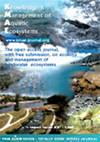英国水生昆虫对气候变化的脆弱性
IF 1.7
3区 环境科学与生态学
Q3 FISHERIES
引用次数: 2
摘要
由于水环境的物理特性与生活在其中的物种之间的内在联系,淡水生态系统特别容易受到气候变化的威胁。五月蝇、石蝇和球蝇是淡水环境健康的关键指标,它们的生物学特性和生态偏好决定了它们对气候变化的脆弱性。对289种英属植物的性状和偏好进行了分析,结果表明,变异、飞行时间长短、海拔偏好和对水源的亲和性是造成易损性的主要因素。16个物种被认为受到气候变化的威胁。这些物种分布在英国各地,但特别脆弱的热点地区出现在高地地区。应针对这些地区采取缓解措施,以减少气候变化对水生昆虫种群的影响。本文章由计算机程序翻译,如有差异,请以英文原文为准。
The vulnerability of British aquatic insects to climate change
Freshwater ecosystems are particularly at risk from climate change due to the intrinsic link between the physical properties of the water environment and those species that live there. Mayflies, stoneflies and caddisflies are key indicators of the health of freshwater environments and their biological traits and ecological preferences determine their vulnerability to climate change. Traits and preferences for 289 British species were analysed, with voltinism, length of flight period, altitudinal preference and affinity to headwaters being the main factors causing vulnerability. Sixteen species were deemed to be at risk from climate change. These species are distributed across Great Britain, but particular hotspots of vulnerability are present in upland areas. These areas should be targeted with mitigation measures to reduce the impacts of climate change on populations of aquatic insects.
求助全文
通过发布文献求助,成功后即可免费获取论文全文。
去求助
来源期刊

Knowledge and Management of Aquatic Ecosystems
环境科学-海洋与淡水生物学
CiteScore
3.70
自引率
5.60%
发文量
22
审稿时长
>12 weeks
期刊介绍:
Knowledge and Management of Aquatic Ecosystems (KMAE-Bulletin Français de la Pêche et de la Pisciculture since 1928) serves as a foundation for scientific advice across the broad spectrum of management and conservation issues related to freshwater ecosystems.
The journal publishes articles, short communications, reviews, comments and replies that contribute to a scientific understanding of freshwater ecosystems and the impact of human activities upon these systems. Its scope includes economic, social, and public administration studies, in so far as they are directly concerned with the management of freshwater ecosystems (e.g. European Water Framework Directive, USA Clean Water Act, Canadian Water Quality Guidelines, …) and prove of general interest to freshwater specialists. Papers on insular freshwater ecosystems and on transitional waters are welcome. KMAE is not a preferred journal for taxonomical, physiological, biological, toxicological studies, unless a clear link to ecological aspects can be established. Articles with a very descriptive content can be accepted if they are part of a broader ecological context.
 求助内容:
求助内容: 应助结果提醒方式:
应助结果提醒方式:


